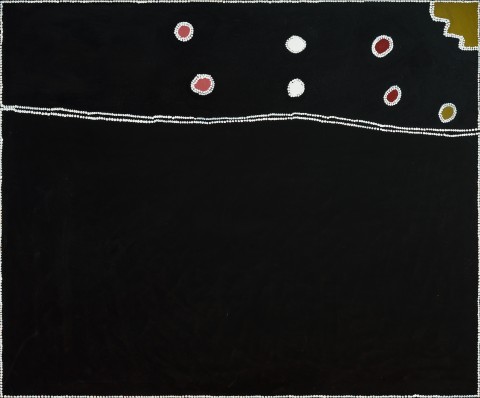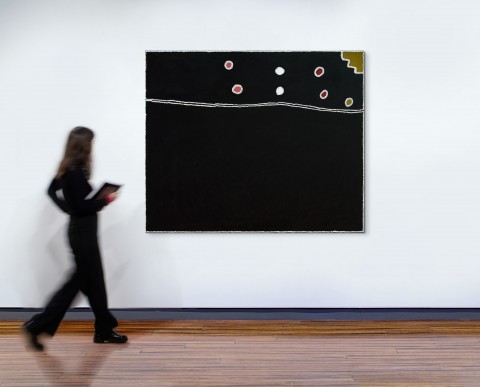PIPE CREEK CATTLE PLAIN CATTLE CAMP, 2008
FREDDIE TIMMS
ochres and pigment with synthetic binder on Belgian linen
150.0 x 180.0 cm
bears inscription verso: artist's name, title, size and Waringarri Aboriginal Arts cat. 375412
Waringarri Aboriginal Arts, Kununurra, Western Australia
The Estate of Freddie Timms
In a career that spanned more than 30 years, Freddie Timms was recognised as the foremost painter amongst the second generation of Gija artists. He became known for painting works that chronicled the interactions between the Gija and the settler-colonisers, recording the devastating consequences on the local people and landscape from the effects of colonisation and station life in the cattle industry. Utilising a reserved palette and an economy of space, his balanced compositions conform to the East Kimberley archetype, originated by Rover Thomas, but are recognisably his own with discrete areas of colour outlined in double rows of white dots. He is noted for his careful aerial landscapes and mapping that are not necessarily inspired by the Ngarranggarni, but often stem from personal experience.
Timms lived as a child on Bow River and Lissadell Stations, later working as a stockman and fencer on several stations throughout the East Kimberley. He knew Rover Thomas when they both worked at Bow River and Texas Downs, where Timms danced and helped paint boards for early performances of Thomas’ Gurirr-Gurirr. He first began painting in the mid-1980s while living at Frog Hollow, south of Turkey Creek, obtaining canvases from Joel Smoker of Waringarri Arts who at the time was supplying canvases to Jack Britten, Rover Thomas, Hector Jandany and his father-in-law, George Mung-Mung. Timms’ paintings were first shown in the Waringarri group exhibition Turkey Creek: Recent Work (1989), held at Deutscher Gertrude Street, Melbourne – an exhibition which signalled the emergence of the East Kimberley school.
Part of Lissadell Station – approximately 200 kilometres to the south of Kununurra and north-east of the Warmun Community on the edge of Lake Argyle – Pipe Creek Plain Cattle Camp is a place Timms knew well from his works as a stockman on Lissadell, a time he remembers as of ‘hard times but good times.’1 Like many of his paintings, this work evokes features of the landscape such as black and red soils, the sandy ground, hills, creeks, and water holes. It shows roads, stockyards, and at a spiritual level, Ngarranggarni or dreaming places. The site is characterised by black soils and is a haven for wildlife, boab trees and permanent water.
Timms was pivotal in the establishment of Jirrawun Aboriginal Art Corporation in 1998 and, with the assistance of Tony Oliver, Jirrawun began to market the work of a wide group of Kimberley artists including Paddy Bedford, Hector Jandany, Rusty Peters, Goody Barrett, Phyllis Thomas, and his father’s brother, Timmy Timms.
1. Timms in conversation with Georges Petijean 22 August 2002, ‘Contemporary Art from the East Kimberley: An Overview’, in Beyond Sacred: Australian Aboriginal Art: The Collection of Colin and Elizabeth Laverty, Edition II, Kleimeyer Industries Pty Ltd, Melbourne, 2011, p. 212
CRISPIN GUTTERIDGE

